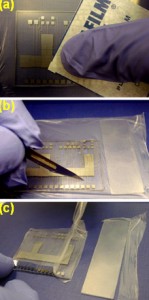Mais J. Jebrail, Nelson Lafreniere, Hao Yang and Aaron R. Wheeler
Department of Chemistry, University of Toronto, Ontario, Canada
Why is this useful?
Digital microfluidics (DMF) is a technique in which droplets of reagents in micro- to nano-liter volumes are manipulated by applying a series of electrical potentials to an array of electrodes[1]. In DMF devices, the actuation electrodes are coated with an insulating layer. Upon application of electrical potentials, charges accumulate on either side of the insulator, a phenomenon that can be exploited to make droplets move, merge, mix, split, and dispense from reservoirs. The insulating layer is covered by an additional hydrophobic coating, which reduces droplet sticking to the surface[2]. The instruments and materials required for forming these layers are expensive (tens-to-hundreds of thousands of dollars) and the deposition methods are time-consuming (many hours). We recently [3] demonstrated a new strategy for reusing DMF devices by fitting them with insulating polymer coverings (e.g., food wrap) that are spin-coated with Teflon. Here, we share an even simpler method that is cheap (tens of dollars) and fast (minutes) featuring a two-for-one insulating and hydrophobic layer formed from laboratory wrap (Parafilm®, Alcan Packaging, Neenah, WI). No Teflon is required for fabricating these devices, and we speculate that this will be useful for laboratories interested in rapid prototyping for various applications.
What do I need?
- Bottom substrate patterned with working electrodes (typically chromium or gold on glass); electrodes can be formed using conventional cleanroom techniques [4,5] or by rapid prototyping techniques such as microcontact printing [6], laser toner printing [7], or marker masking [8]
- Indium-tin-oxide coated glass (can be purchased from Delta Technologies Ltd, Stillwater, MN) to serve as top substrate
- Parafilm® and wax paper backing
- Scissors
- Scalpel
- Hot plate
How do I do it?
1. With scissors, cut a piece of Parafilm® and stretch the film horizontally and vertically to its limits (a), and place over the bottom plate of the DMF device (with patterned electrodes) (b)
2. With a wax paper apply pressure with your finger on the film to release any air trapped between the electrode(s) and film (a). Then, score film with a scalpel and peel off excess Parafilm® (b,c).
3. Repeat steps 1 and 2 to apply parafilm layer to the top substrate (indium-tin oxide coated glass)
4. Place substrates on hotplate for 30 seconds at 80-85°C.
5. Allow substrates to cool down to room temperature (a), and then assemble the device with a top plate4,5 to dispense, merge and split droplets as shown in Figure (b-e).
What else should I know?
- A ~4.5 x 4.5 cm piece of Parafilm® stretched to its limits will give a thickness of 6 – 9 mu.gifm.
- A voltage of 300 – 500V is appropriate for actuation for above thickness.
- Use of wax paper when applying pressure is important as it avoids contamination of Parafilm® surface.
- Device can be recycled by simply peeling off old Parafilm® and replacing it with a new film.
References
[1] A. R. Wheeler, Science, 2008, 322, 539.
[2] J. Lee, H. Moon, J. Fowler, T. Schoellhammer, C. J. Kim, Sens. Actuator A-Phys., 2002, 95, 259.
[3] H. Yang, V. N. Luk, M. Abdelgawad, I. Barbulovic-Nad and A. R. Wheeer, Anal. Chem., 2009, 81, 1061.
[4] M. G. Pollack, A. D. Shenderov and R. B. Fair, Lab Chip, 2002, 2, 96.
[5] S. K. Cho, H. J. Moon and C. J. Kim, J. Microelectromech. Syst., 2003, 12, 70.
[6] M. W. L. Watson, M. Abdelgawad, G. Ye, N. Yonson, J. Trottier and A. R. Wheeler, Anal. Chem., 2006, 78, 7877.
[7] M. Abdelgawad and A. R. Wheeler, Adv. Mater., 2007, 19, 133.
[8] M. Abdelgawad and A. R. Wheeler, Microfluid. Nanofluid., 2008, 4, 349.













